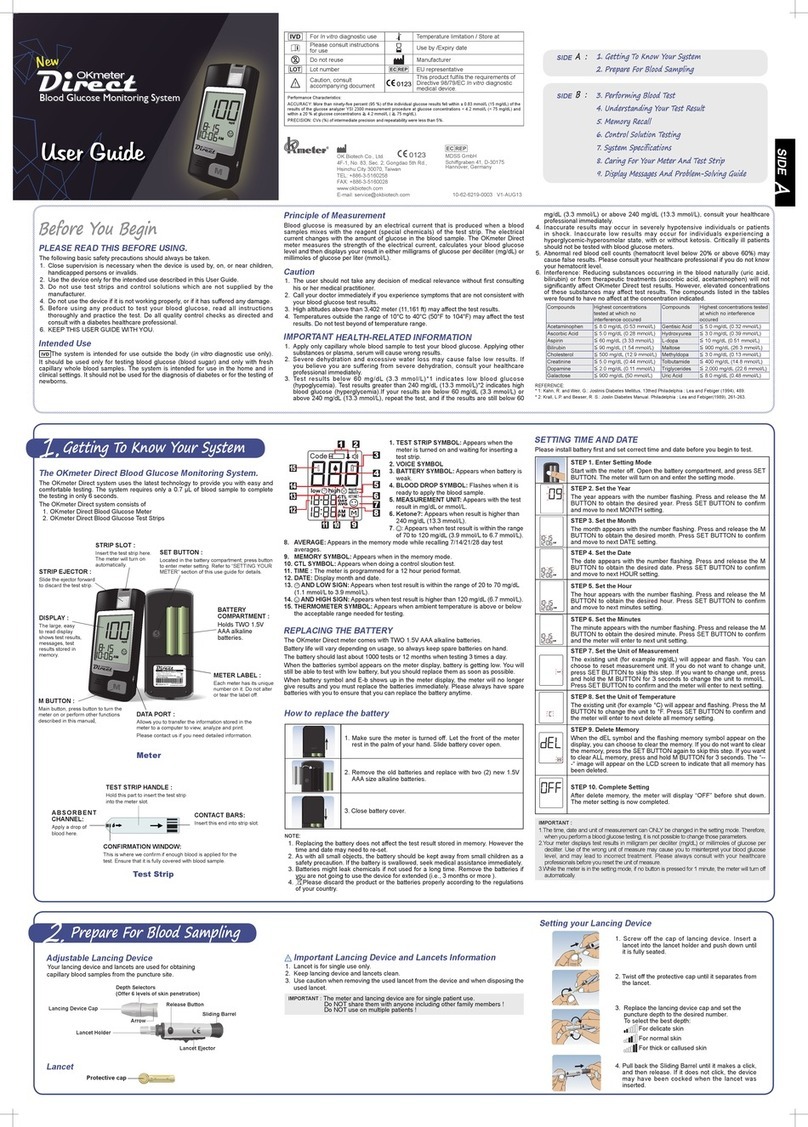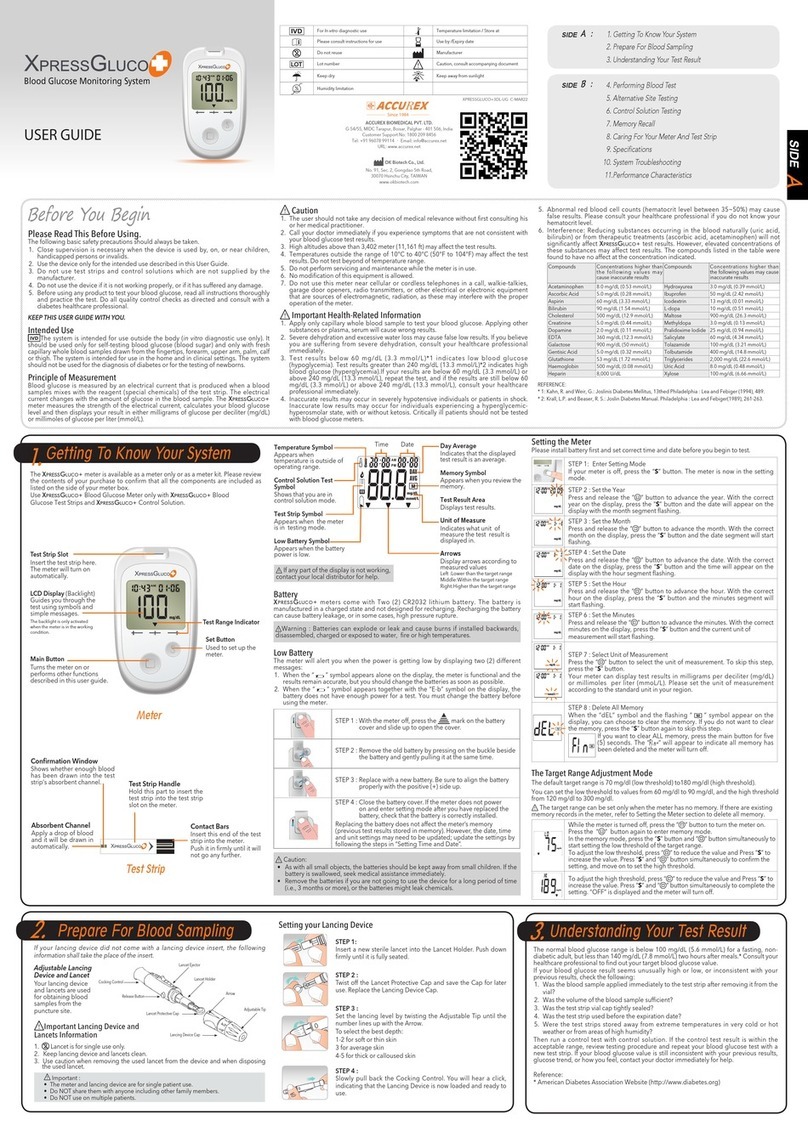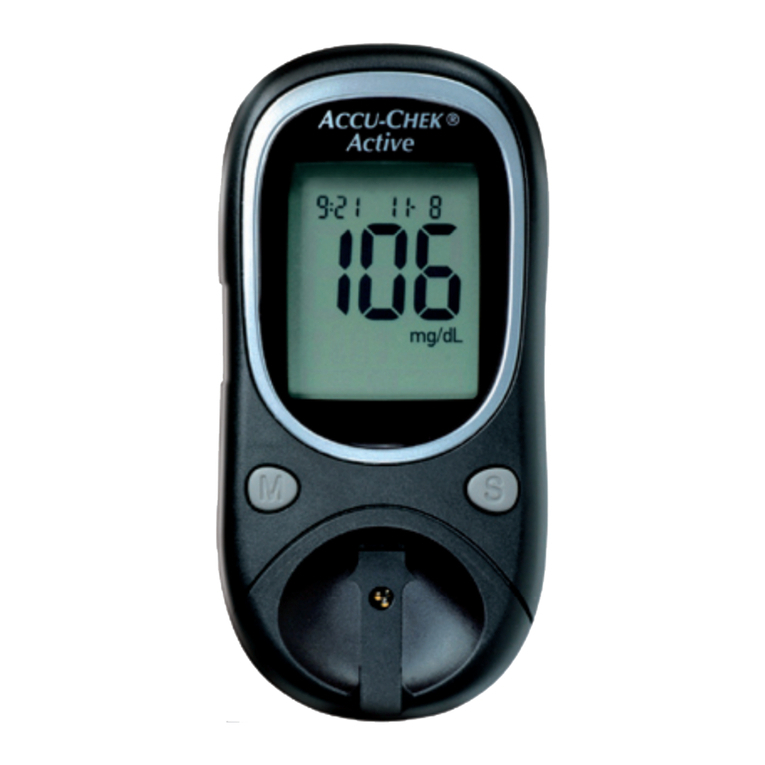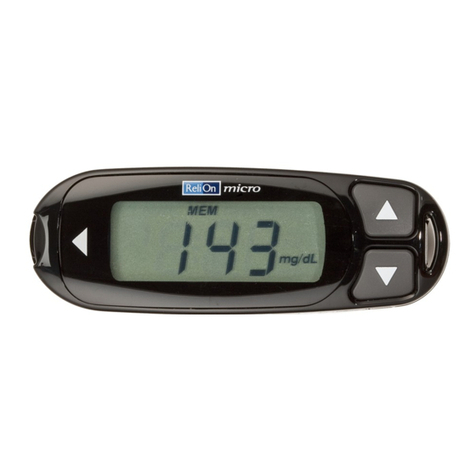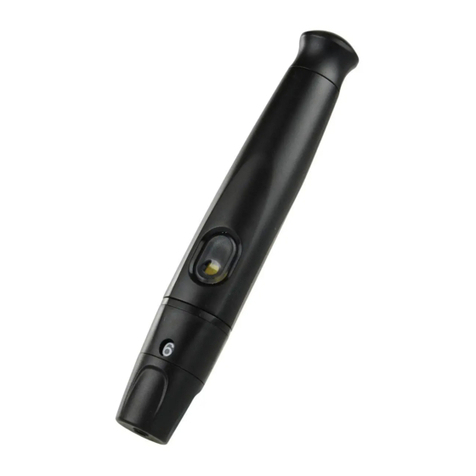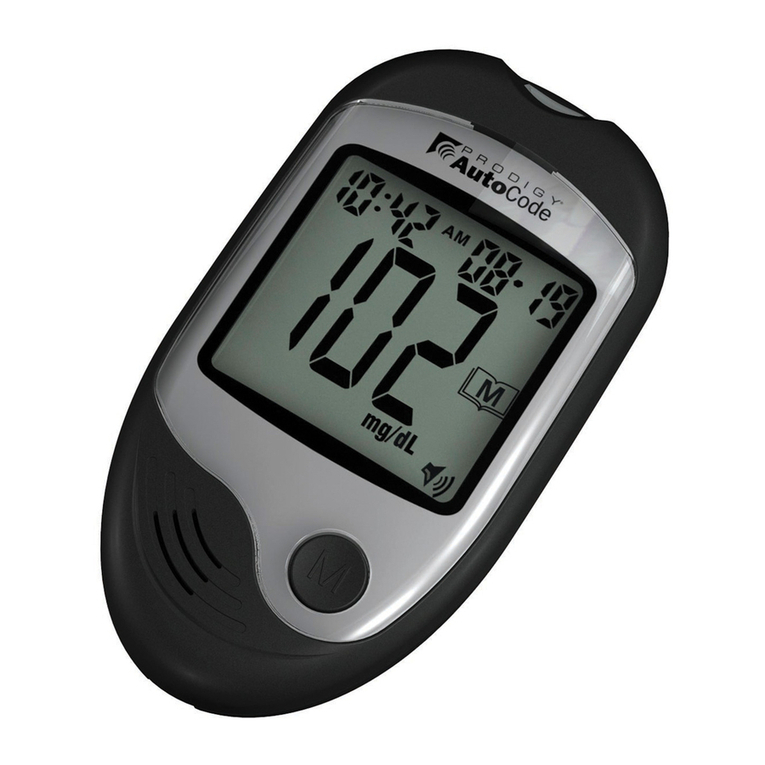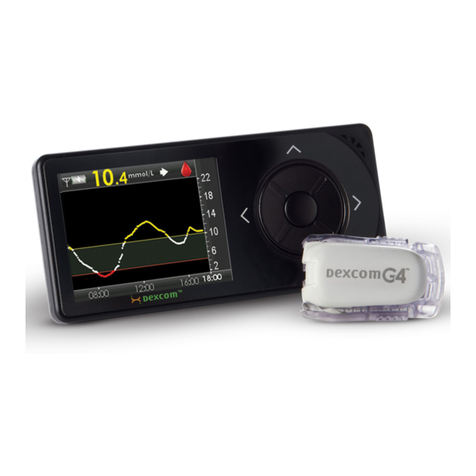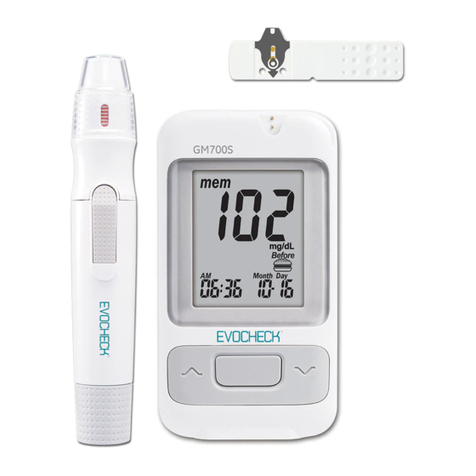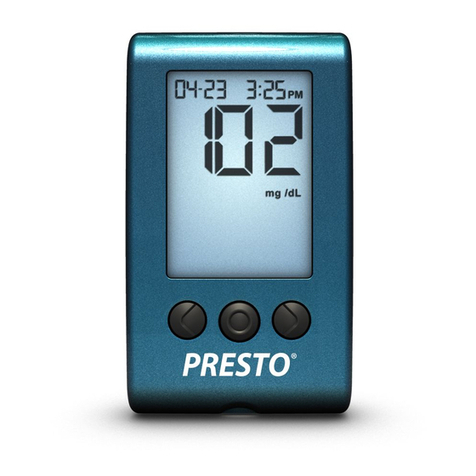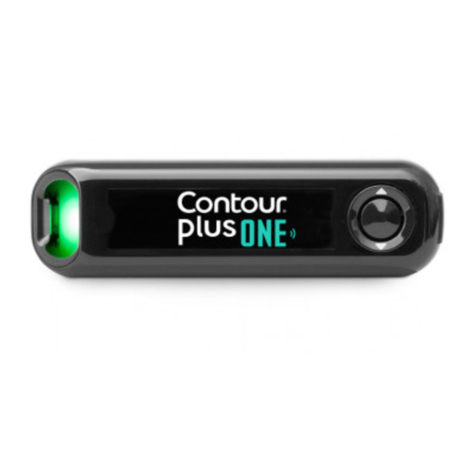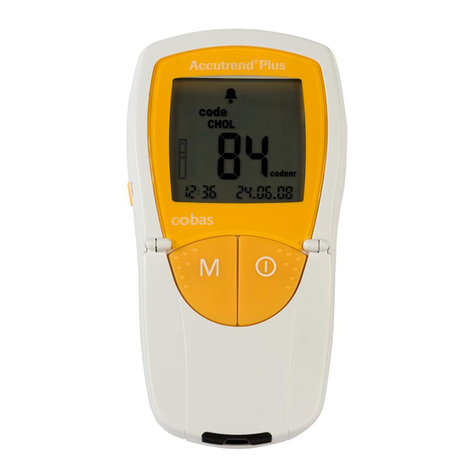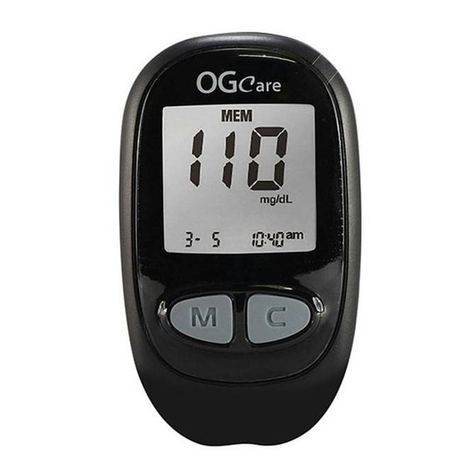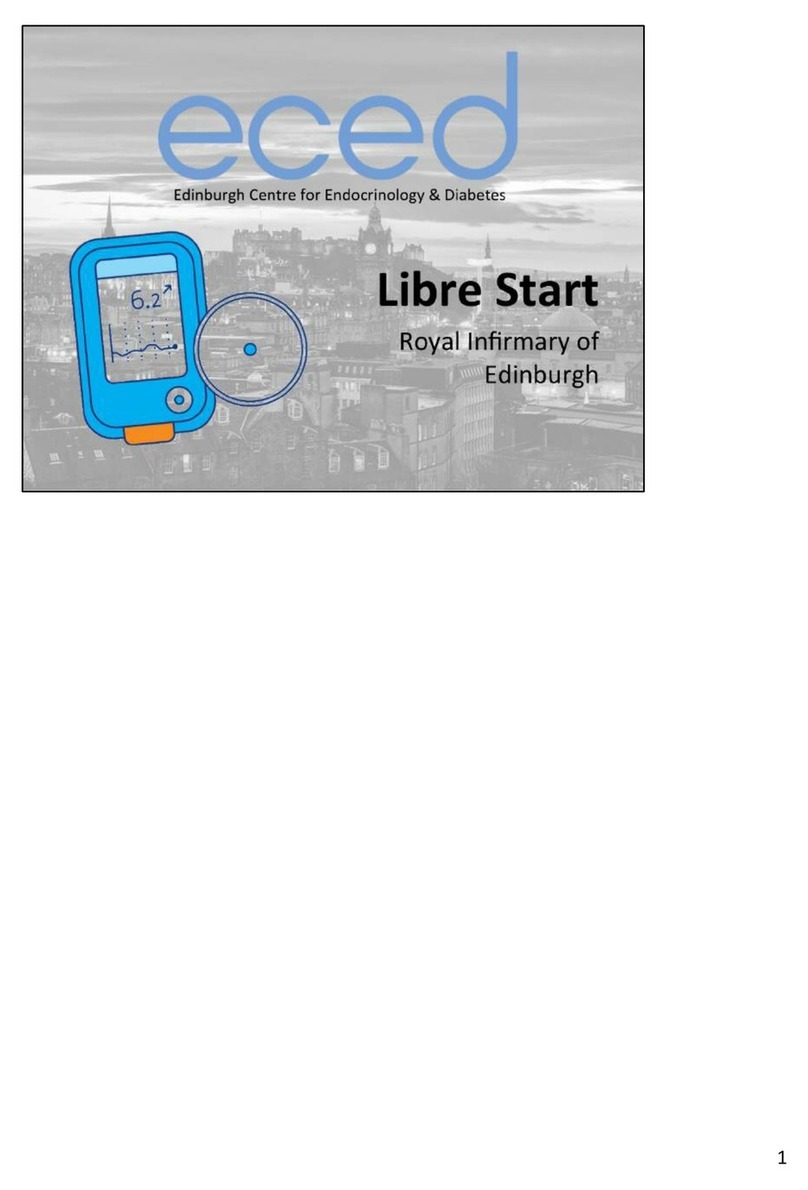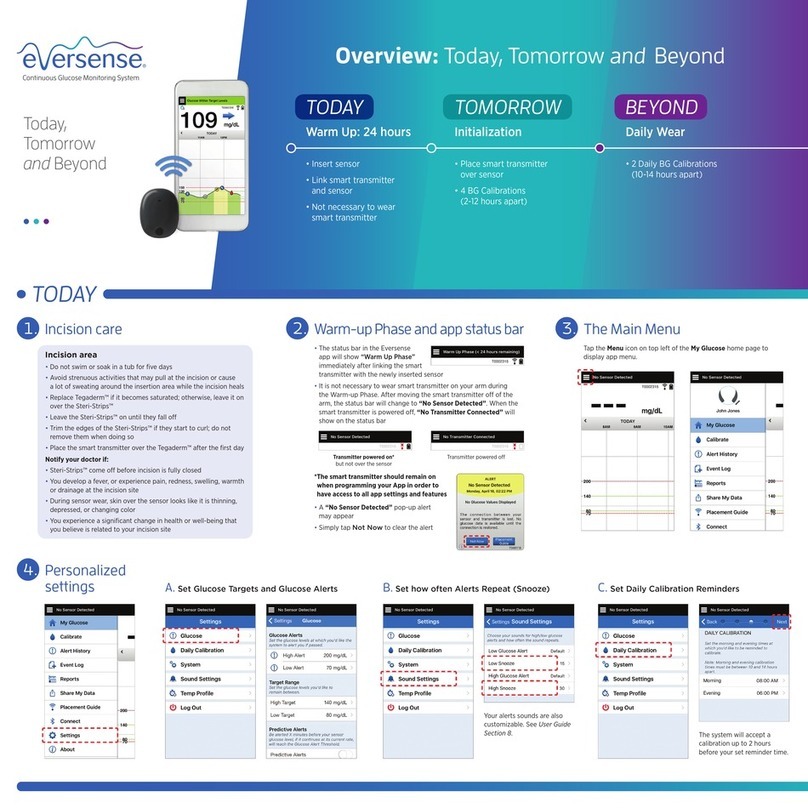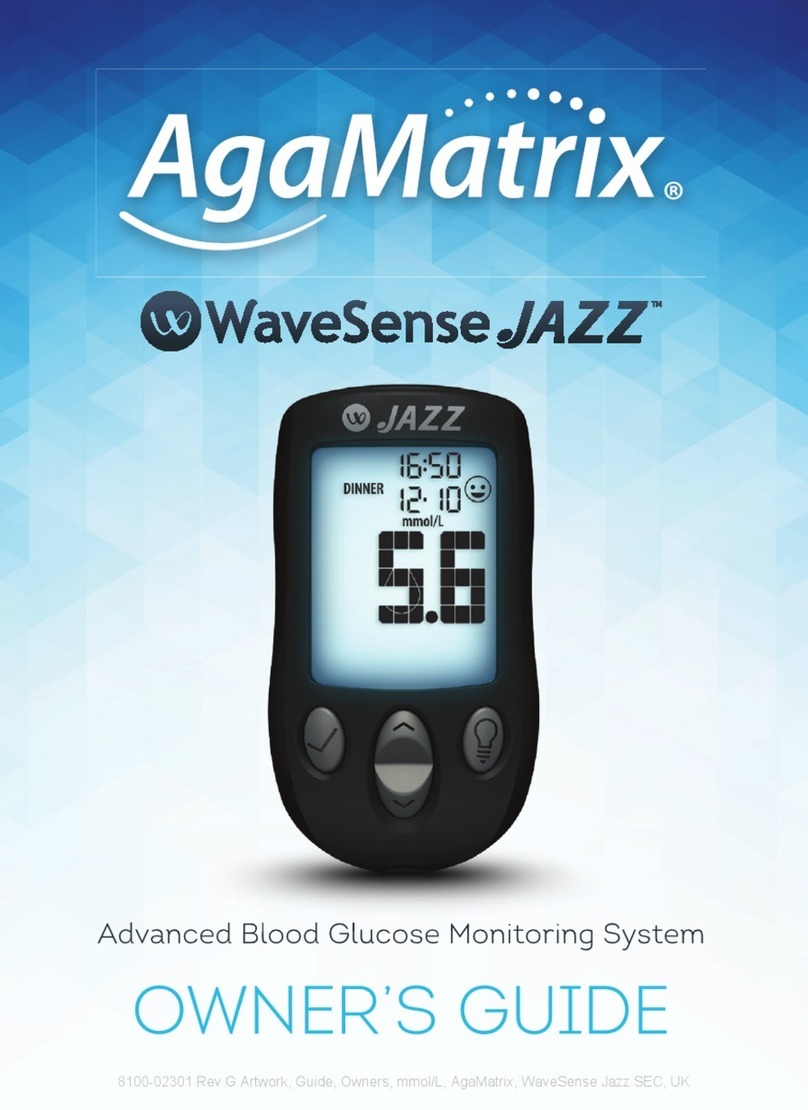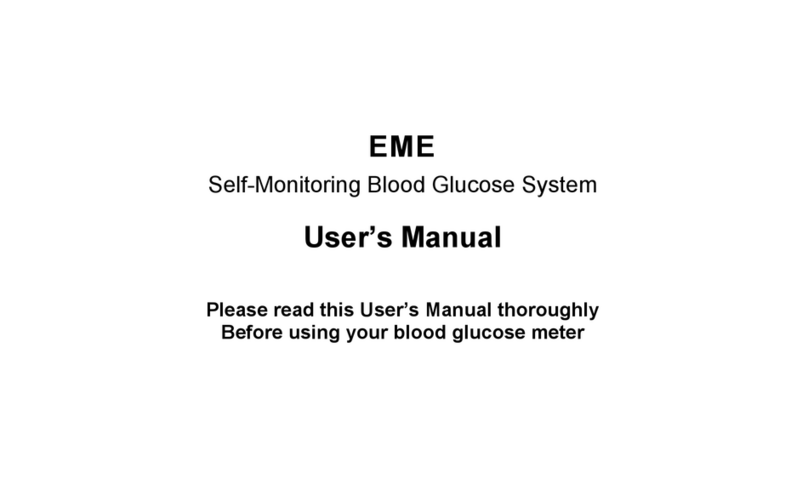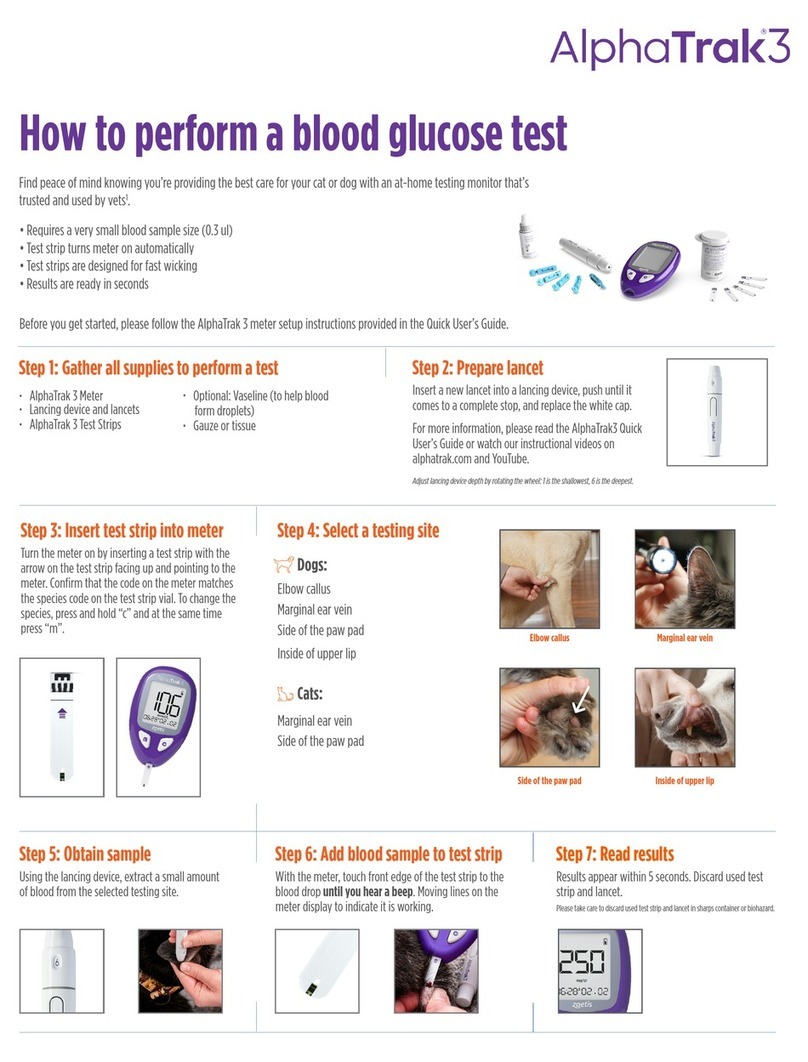OK Biotech OKmeter Hitech User manual

SIDE
Before You Begin
PLEASE READ THIS BEFORE USING.
The following basic safety precautions should always be taken.
1. Close supervision is necessary when the device is used by, on, or near children,
handicapped persons or invalids.
2. Use the device only for the intended use described in this manual.
3. Do not use test strips and control solutions which are not supplied by the
manufacturer.
4. Do not use the device if it is not working properly, or if it has suffered any damage.
5. Before using any product to test your blood glucose, read all instructions
thoroughly and practice the test. Do all quality control checks as directed and
consult with a diabetes healthcare professional.
6. KEEP THESE USER GUIDE WITH YOU.
Intended Use
The system is intended for use outside the body (in vitro diagnostic use only).
It should be used only for testing blood glucose (blood sugar) and only with fresh
capillary whole blood samples. The system is intended for use in the home and in
clinical settings. It should not be used for the diagnosis of diabetes or for the testing of
newborns.
ATTACH YOUR STRIP BOTTLE TO THE METER
The OKmeter Hitech meter is designed to attach together with your OKmeter
Hitech strip bottle. Before you begin to test, please follow below procedure to
attach the strip bottle rst.
1.Take strip vial from box.
2.Attach the bottle to the holder of meter as illustration.
3.Push bottle down until the meter is located in the middle of bottle.
Getting To Know Your System
The OKmeter Hitech Blood Glucose Monitoring System.
INCLUDED IN YOUR KIT:
a. One OKmeter Hitech Meter(battery included).
b. OKmeter Hitech Test Strips.
c. Lancing Device (if another type of lancing device was included, see the separate
instructions that come with that lancing device)
d. Sterile Lancet
AVAILABLE SEPERATELY:
e. OKmeter Control Solution(ask for control solution where you obtain your test
strips)
WARNING: Keep the meter and testing supplies away from young children. Small
items as the battery cover, battery, test strips, lancets, and control solution vial cap
are choking hazards.
Prepare For Blood Sampling
Adjustable Lancing Device
Your lancing device and lancets are used for obtaining
capillary blood samples from the puncture site.
Lancet
Important Lancing Device and Lancets Information
1. Lancet is for single use only.
2. Keep lancing device and lancets clean.
3. Use caution when removing the used lancet from the device and when
disposing the used lancet.
4. The lancing device and lancets are in conformity with MDD 93/42/EEC. Refer
to product labels for contact information of manufacturer and CE marking.
Important : The meter and lancing devic are for single patient use.
Do NOT share them with anyone including other family members !
Do NOT use on multiple patients !
Principle of Measurement
Blood glucose is measured by an electrical current that is produced when a blood
samples mixes with the reagent (special chemicals) of the test strip. The electrical
current changes with the amount of glucose in the blood sample. The OKmeter Hitech
meter measures the strength of the electrical current, calculates your blood glucose
level and then displays your result in either milligrams of glucose per deciliter (mg/dL) or
millimoles of glucose per liter (mmol/L).
Caution
1. The user should not take any decision of medical relevance without rst consulting
his or her medical practitioner.
2. Call your doctor immediately if you experience symptoms that are not consistent with
your blood glucose test results.
3. High altitudes above than 3,402 meter (11,161 ft) may affect the test results.
4. Temperatures outside the range of 5°C to 45°C (41°F to 113°F) may affect the test
results. Do not test beyond of temperature range.
IMPORTANT HEALTH-RELATED INFORMATION
1. Apply only capillary whole blood sample to test your blood glucose. Applying other
substances or plasma, serum will cause wrong results.
2. Severe dehydration and excessive water loss may cause false low results. If
you believe you are suffering from severe dehydration, consult your healthcare
professional immediately.
3. Test results below 60 mg/dL (3.3mmol/L)*1 indicates low blood glucose
(hypoglycemia). Test results greater than 240 mg/dL (13.3mmol/L)*2 indicates high
blood glucose (hyperglycemia).If your results are below 60 mg/dL(3.3mmol/L) or
above 240 mg/dL(13.3mmol/L), repeat the test, and if the results are still below 60
mg/dL(3.3mmol/L) or above 240 mg/dL(13.3mmol/L), consult your healthcare
professional immediately.
4. Inaccurate results may occur in severely hypotensive individuals or patients
in shock. Inaccurate low results may occur for individuals experiencing a
hyperglycemic-hyperosmolar state, with or without ketosis. Critically ill patients
should not be tested with blood glucose meters.
5. Abnormal red blood cell counts (hematocrit level below 20% or above 60%) may
cause false results. Please consult your healthcare professional if you do not know
your hematocrit level.
6. Interference: Reducing substances occurring in the blood naturally (uric acid,
bilirubin) or from therapeutic treatments (ascorbic acid, acetaminophen) will not
signicantly affect OKmeter Hitech test results. However, elevated concentrations
of these substances may affect test results. The compounds listed in the tables
were found to have no affect at the concentration indicated.
Compounds Lowest concentrations
tested at which no
interference occured
Compounds Lowest concentrations tested
at which no interference
occured
Acetaminophen ≦8.0 mg/dL (0.53 mmol/L) Gentisic Acid ≦5.0 mg/dL (0.32 mmol/L)
Ascorbic Acid ≦5.0 mg/dL (0.28 mmol/L) Hydroxyurea ≦3.0 mg/dL (0.39 mmol/L)
Aspirin ≦60 mg/dL (3.33 mmol/L) L-dopa ≦10 mg/dL (0.51 mmol/L)
Bilirubin ≦90 mg/dL (1.54 mmol/L) Maltose ≦900 mg/dL (26.3 mmol/L)
Cholesterol ≦500 mg/dL (12.9 mmol/L) Methyldopa ≦3.0 mg/dL (0.13 mmol/L)
Creatinine ≦5 mg/dL (0.44 mmol/L) Tolbutamide ≦400 mg/dL (14.8 mmol/L)
Dopamine ≦2.0 mg/dL (0.11 mmol/L) Triglycerides ≦2,000 mg/dL (22.6 mmol/L)
Galactose ≦900 mg/dL (50 mmol/L) Uric Acid ≦8.0 mg/dL (0.48 mmol/L)
REFERENCE:
* 1: Kahn, R. and Weir, G.: Joslinis Diabetes Mellitus, 13thed Philadelphia : Lea and Febiger (1994), 489.
* 2: Krall, L.P. and Beaser, R. S.: Joslin Diabetes Manual. Philadelphia : Lea and Febiger(1989), 261-263.
Setting your Lancing Device
1. Screw off the cap of lancing device. Insert a
lancet into the lancet holder and push down until
it is fully seated.
2. Twist off the protective cap until it separates from
the lancet.
3. Replace the lancing device cap and set the
puncture depth to the desired number.
NOTE: THE DEPTH SELECTOR OFFERS 5 LEVELS OF SKIN
1-2 : FOR SOFT OR THIN SKIN
3 : FOR AVERAGE SKIN
4-5 : FOR THICK OR CALLOUSED SKIN
4. Pull back the cocking control until it makes a
click, and then release. If it does not click, the
device may have been cocked when the lancet
was inserted.
IMPORTANT:
The meter will store your latest test result. If you want to recall your last result,
please insert the strip into meter, and the result will be shown in the meter display
for 2 seconds before the blink dot displayed.
Performing Blood Test
1. Wash your hands in warm, soapy water. Rinse and dry
completely. Warm your ngers to increase blood ow.
2. Remove a new test strip from vial. Be sure to tightly
replace vial cap after removing test strips. Insert test
strip immediately into strip slot as illustrated. The
meter turns on automatically.
3. The meter will show your last test result for 2 seconds,
then the blink dot displayed, now the meter is ready for
test.
4. Hold the prepared lancing device firmly against the
side of your ngertip. Press release button.
(NOTE: If you want to do alternative site testing, please
refer to the “About Alternative Site Testing (AST)”
Section. Please consult your healthcare professional
before obtaining blood from site other than your
ngertip.)
mmol/L
5. Gently massage your nger or puncture site to obtain the
required blood volume. To perform the test, you need
only 0.7μL of blood sample. Do not smear the blood
sample. To obtain best accurate result, wipe off the rst
drop of blood and gently squeeze another drop of blood.
6. Apply the blood sample to the test strip until the
conrmation window is fully covered with blood.
7. Then the meter begins to count down and shows up test
result in 5 seconds.
8. Turn the meter off by removing the test strip. Discard
the used strip and lancet safely in a puncture resistant
container.
REPLACE BATTERY
The meter comes with ONE Lithium batteries (battery type CR2032)
(preinstalled when new purchasing). The battery should last about 3000 tests.
When you insert strip and found the meter blinks “E-b” for 5 time and then turn
off, the battery is dead.
The meter will no longer give results. If you want to replace new battery,
please follow below procedure.
1. Make sure the meter is turned off.
Pull out the battery component as
illustration.
2. With the positive (+) side up, place
the battery (battery type CR2032) in
the compartment.
3. Push back the battery component to
the meter.
IMPORTANT:
1.Your meter can display test result in milligram per deciliter (mg/dL) or
millimoles per liter (mmol/L). The mg/dL unit is standard in the United
States. The mmol/L unit is standard in Canada and European countries.
Your meter has been preset at the factory with the standard unit
measurement used where you live. When you replace the battery, the unit
of measurement will not be changed. If you want to change the unit of
measurement, please contact with us or local distributor for help.
2.Please discard the used or dead batteries properly according to the
regulations of your country.
DISPLAY :
shows test results and
messages.
STRIP BOTTLE HOLDER :
This is the place that you
can insert and hold the strip
bottle here.
METER LABEL :
Each meter has its unique
number on it. Do not alter
or tear the label off.
STRIP SLOT :
Insert the test strip here.
The meter will turn on
automatically.
Meter
ABSORBENT
CHANNEL:
apply a drop of
blood here.
CONFIRMATION
WINDOW:
this is where we
conrm if enough
blood is applied for
has been drawn
into strip.
CONTACT BARS:
Insert this end into
strip slot.
TEST STRIP
HANDLE
Test Strip
Lancing Device Cap
Lancet Holder
Depth Selector
Release Button
Cocking Control
Lancet Ejector
Protective cap
Incorrect Correct
Understanding Your Test Result
The normal blood glucose range is 70 to 105 mg/dL (3.9 to 5.8 mmol/L) for a
fasting, non-diabetic adult, but less than 140 mg/dL (7.8 mmol/L) two hours after
meals. Consult your healthcare professional to nd out your target blood glucose
value.
If your blood glucose result seems unusually high or low, or inconsistent with your
previous results, check the following:
1. Was the blood sample applied immediately to the test strip after removing it from
the vial?
2. Was the volume of the blood sample sufcient?
3. Was the test strip vial cap tightly sealed?
4. Was the test strip used before the expiration date?
5. Were the test strips stored away from extreme temperatures in very cold or hot
weather or from areas of high humidity?
Then run a control test with OKmeter control solution. If the control test result
is within the acceptable range, review testing procedure and repeat your blood
glucose test with a new test strip. If your blood glucose value is still inconsistent
with your previous results, glucose trend, or how you feel, contact your doctor
immediately for help.
OK Biotech Co., Ltd.
4F-1, No. 83, Sec. 2, Gongdao 5th Rd.,
Hsinchu City, 30070, Taiwan
TEL: +886-3-5160258
FAX: +886-3-5160028
www.okbiotech.com
MDSS GmbH
Schiffgraben 41, D-30175 Hannover, Germany
1.
2
.
3
.
4
.
A
1
. Getting To Know Your System
2. Prepare For Blood Sampling
3. Performing Blood Test
4. Understanding Your Test Result
5. Control Solution Testing
6. Caring For Your Meter And Test Strip
7. System Specifications
8. symbols Description
9. About Alternative Site Testing (AST)
10. Display Messages And Problem-Solving Guide
SIDE
A :
SIDE
B :
mmol/L
User GUIDE
10-62-2310-0003 V1-JUL11
Blood Glucose
Monitoring System

SIDE
Control Solution Testing
OKmeter control solutions contain a known amount of glucose that reacts with
OKmeter Hitech test strips. By testing your control solution and comparing the test
results with the expected range printed on the test strip vial label, you can make sure
that the meter and the test strips are working properly together as a system and that
you are performing the test correctly. It is very important that you do this simple check
routinely to make sure you get accurate results.
Why perform a control solution test?
1. To ensure that your meter and test strip are working properly together.
2. To allow you to practice testing without using your own blood.
When should the control solution test be performed?
1. When you rst get your OKmeter Hitech meter. Before use this system to test your
blood, you can practice the procedure by using control solution. When you can do
three tests in a row that are within the expected range, you are ready to test your
blood.
2. Once a week (to make sure that you continue to get accurate results)
3. When you begin using a new vial of test strips.
4. Whenever you suspect that the meter or test strips are not working properly.
5. When your blood glucose test results are not consistent with how you feel, or
when you think your results are not accurate.
6. When test strips are exposed to extreme environmental conditions.
7. If you drop the meter.
Important Control Solution Information
1. Check the expiration date on the control solution bottle. Do not use if expired.
2. Control solution, meter, and test strips should come to room temperature (68-77
ºF/20-25ºC) before testing.
3. Shake the bottle before use, discard the first drop of control solution after
squeezing, wipes off the dispenser tip to avoid contaminations. These steps
ensure you will get a good sample and an accurate result.
4. The discard date for control solution is 30 days after first opening. Record the
discard date on the bottle, when you open a new bottle of control solution.
5. Store the control solution closed at temperatures below 30ºC (86ºF). Do not
refrigerate.
NOTE : 1. There are two levels of control solution (normal and high) available to
purchase. Please contact with your local distributor when required.
2.The control solution range printed on the test strip vial is for OKmeter
Control Solution only. It is used to test meter and strip performance. It is
not recommended range for your blood glucose level.
How to Perform a Control Test
NOTE : 1. DO NOT APPLY THE CONTROL SOLUTION DIRECTLY TO THE TEST
STRIP! Overdosed solution may give inaccurate result.
2. Repeat test if test result falls outside the control range stated on the test
strip label. If subsequent test remains to produce unacceptable result,
the meter or test strip may be faulty. DO NOT use the system. Contact
us or your local distributor for help.
About Alternative Site Testing
(AST )
There are important limitations for doing AST. Please consult your healthcare
professional before you perform AST.
What is AST?
Alternative Site Testing (AST) means you can use parts of the body other than your
ngertips to check your blood glucose levels. The OKmeter Hitech allows you to test
from the palm, forearm, upper arm, calf or thigh, with equivalent results to ngertip
testing.
What is the advantage?
Fingertips feel pain more readily because they are full of nerve endings (receptors).
At other body sites, nerve endings are not so numerous and you will not feel as much
pain as you will experience at the ngertip.
When to use AST?
Food, medication, illness, stress and exercise can affect blood glucose levels.
Capillary blood at ngertip reects these changes faster than capillary blood at other
sites. Therefore, if you are testing blood glucose level during or immediately after
meal, physical exercise or stressful event, take the blood sample from your ngertip
only.
Use AST only:
1. In a pre-meal or fasting state (more than 2 hours since the last meal).
2. Two hours or more after taking insulin.
3. Two hours or more after exercise.
4. During steady state blood glucose conditions.
Do NOT use AST if:
1. You have reason to believe you have hypoglycemia or hyperglycemia.
2. Your routine glucose results are often uctuating.
3. You are pregnant.
Display Messages And
Problem-Solving Guide
The following is a summary of some display messages and symbols. These messages
help to identify certain problems but do not appear in all cases when a problem has
occurred.
Improper use may cause an inaccurate result without producing an error message.
In the event of a problem, refer to information under ‘‘action to take’’
Display Description Action To Take
Blinking dot The meter is ready for
blood applying into test
strip.
Test result is higher than
600 mg/dL (33.3 mmol/L) If this is not conrmed by
the way you feel, review
proper testing procedure
and perform a control test.
Repeat blood test, if the
display still appears, please
call medical assistance
immediately.
Test result is lower than
20 mg/dL (1.1 mmol/L)
Battery is dead Replace battery now.
mmol/L
1. Insert test strip, this will turn on the meter automatically.
2. The blinking dot signies the meter is ready for testing.
3. Shake control solution bottle well.
Remove the cap. Squeeze bottle,
discard the first drop and wipe off
the dispenser tip with a clean tissue
paper or cotton swab. Squeeze a
drop on clean bottle cap/ngertip /
non-absorbent surface.
4. Then transfer the control solution to the test strip.
5. Test result will show up after 5 seconds. Value should be
within the range suggested on the test strip vial label in
use.
Caring For Your Meter
And Test Strip
To avoid the meter and test strips getting dirt, dust or other contaminants, please
wash and dry your hands thoroughly before use.
Cleaning
Your meter does not require special maintenance. As long as no blood or control
solution comes in direct contact with the meter, there is no special cleaning
required.
To clean the meter exterior, wipe with a cloth moistened with tap water or a mild
cleaning agent, then dry the device with a soft and dry cloth. Do not flush with
water.
Do not use organic solvents to clean the meter. Your meter is a precision
instrument. Please handle it with care.
Storage
1. Meter Storage
* Storage condition: -4ºF~122ºF (-20ºC~50ºC), below 90% relative humidity.
* Avoid dropping and strong impact.
* Avoid direct sunlight and humidity.
2. Strip Storage
* Storage condition: 4ºC~45ºC (39ºF~113ºF), and 10~85% relative humidity. Do
not refrigerate.
* Store your test strips in their original vial only. Do not transfer to other
container.
* Store test strip packages in a cool and dry place. Keep away from direct
sunlight and heat.
* Touch the test strip with clean and dry hands.
* After removing a test strip from the vial, immediately replace the vial cap and
close it tightly.
* Use each test strip immediately after removing it from the vial.
* Do not bend, cut, or alter a test strip in any way.
3. Control solution storage
* Storage condition: Store the control solution tightly closed at temperatures
below 86ºC (30ºC). Do not refrigerate.
How to increase the accuracy?
Stimulating blood perfusion by rubbing the puncture site prior to blood extraction has
a signicant inuence on the glucose value obtained.
Blood from the site without rubbing exhibits a measurably different glucose
concentration than blood from the ngertip. When the puncture site was rubbed prior
to blood extraction, the difference was signicantly reduced.
IMPORTANT :
To increase the accuracy when using AST, rub the puncture site more than 20
seconds before extracting blood.
System Specifications
Model Name OK-7N
Assay Method Electrochemical biosensor
Test Sample Capillary whole blood
Test Result Referenced to plasma glucose value
Alternative Site Testing YES (palm, forearm, upper arm, calf and thigh)
Sample Size 0.7 μL
Measuring Time 5 seconds
Measuring Range 20 – 600 mg/dL (1.1 – 33.3 mmol/L)
Acceptable Hematocrit Range 20~60%
Operating Condition 5°C~45°C(41°F~113°F), 10~85% R. H.
Storage/Transportation Condition 4°C~45°C(39°F~113°F), 10~85% R. H.
Memory Capacity 1 test result
Power Supply One 3-volt Lithium Battery (battery type CR2032)
Battery Life Approximately 3,000 tests
Automatic shut-off In 5 minutes
Dimensions 40mm(L)×26mm(W) ×37.5mm(H)
Weight 16 g included battery
Symbols Description
For
in vitro
diagnostic use. Temperature limitation /
Store at.
Please consult instructions
for use. Use by /Expiry date.
Do not reuse. Manufacturer.
Lot number. EU representative.
Caution, consult
accompanying document.
This product fulls the
requirements of Directive
98/79/EC
in vitro
diagnostic
medical device.
The device has been certied to meet the following standards:
EN ISO 13485:2003, EN ISO 14971:2007-10-01, EN ISO 15197:2003,EN 980:2008, EN ISO 18113-4:2009, IEC/EN60601-1,
IEC/EN60601-1-2, EN61010-1, EN61010-2-101:2002, EN 61326-1, Pr ISO 17511:2003, and EN61326-2-6
Used strip or moistened
strip
Repeat test with a new
test strip. If the display
still appears, contact local
distributor for help.
Temperature is out of the
operating range.
The meter is not working.
Move to an area with
temperature between 5ºC
to 45ºC (41ºF - 113ºF) and
wait at least 30 minutes.
Do not articially heat or
cool the meter.
No responses when strip
is inserted into the meter
Maybe:
1. Battery is dead
2. Wrong strip be inserted
3. Meter is defective
You have to:
1. Replace new battery.
2. Insert the test strip
correctly
3. Contact your local
distributor for help.
No responses when blood
sample is applied to the
strip
Maybe:
1.Blood is not sufcient.
2.Meter is defective
You have to:
1. Repeat test with
sufcient sample.
2. Contact your local
distributor for help.
5
.
6
.
7
.
8
.
9
.
10.
B
This manual suits for next models
1
Other OK Biotech Blood Glucose Meter manuals
